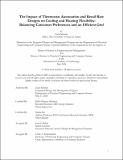The Impact of Thermostat Automation and Retail Rate Designs on Cooling and Heating Flexibility: Balancing Consumer Preferences and an Efficient Grid
Author(s)
Schmitz, Zack
DownloadThesis PDF (8.764Mb)
Advisor
Duenas Martinez, Pablo
Terms of use
Metadata
Show full item recordAbstract
Flexibility in household energy consumption is crucial for improving grid efficiency and reducing peak electricity demand. The ongoing impact of climate change and the move towards electrification worsen these challenges, emphasizing the need for effective peak demand reduction strategies. Current approaches often involve peak pricing retail tariffs, behavioral responses to grid operator notifications, or expensive technologies such as demand-side batteries. However, these methodologies rely on unpredictable consumer participation or substantial capital investments. On the other hand, the growing use of smart thermostats presents an opportunity for passive, efficient control of household energy consumption. Combining smart thermostats with appropriate price signals creates an opportunity to optimize the balance between energy cost and thermal comfort. This work examines the role of smart thermostat automation and dynamic retail rate designs in maximizing heating and cooling flexibility while ensuring consumer comfort. The research introduces a new approach to demand-side management by using reinforcement learning (RL) to optimize thermostat settings based on individual thermal preferences and price signals. A comprehensive testbed simulation framework was developed to analyze these effects, incorporating bottom-up energy modeling, individualized thermal comfort profiles using smart thermostat data, and advanced thermostat controls to investigate the impacts of various rate designs on residential energy demand. The study evaluates these impacts at a population level, considering the effects on over 80 household archetypes across a localized region. Key findings show that partitioned time-of-use rates with moderate pricing shifts effectively reduce energy usage without creating new peaks, unlike more aggressive pricing strategies that can lead to pre-cooling-induced new peaks. These insights offer valuable guidance for policymakers and utility operators in designing rate frameworks that decrease overall electricity consumption and peak demand without compromising personal comfort.
Date issued
2024-05Department
Massachusetts Institute of Technology. Department of Electrical Engineering and Computer Science; System Design and Management Program.Publisher
Massachusetts Institute of Technology